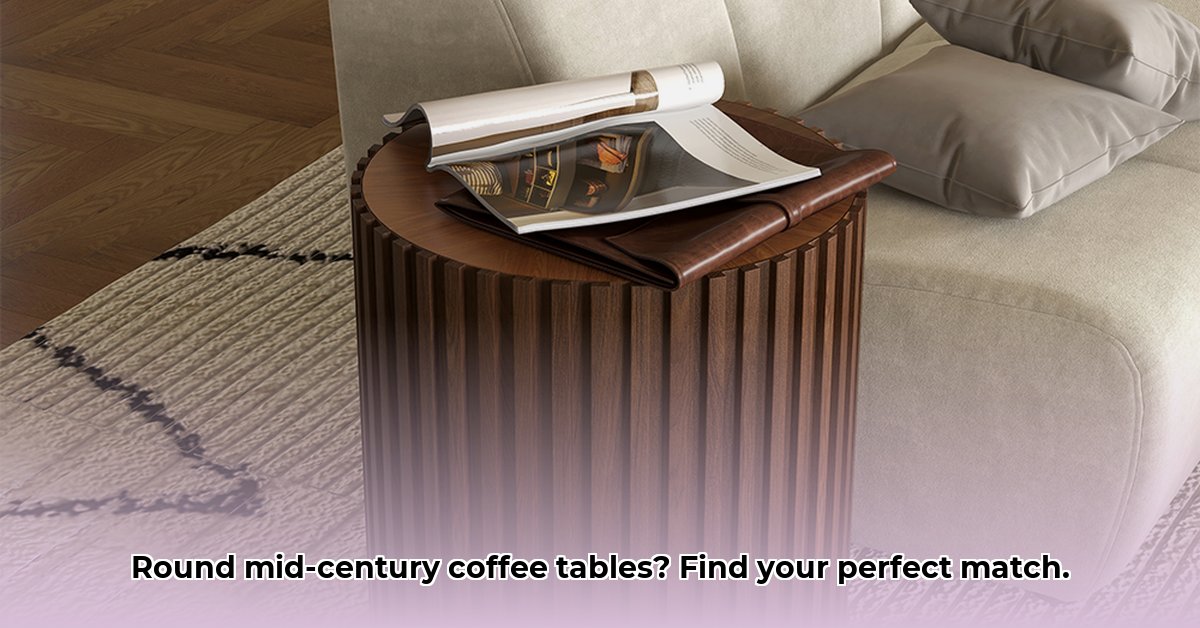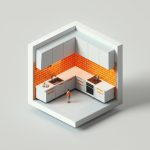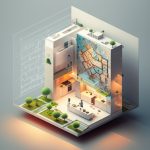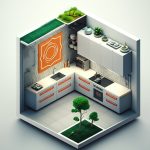Choosing the right coffee table is crucial for adding style and functionality to your living room. A round, mid-century modern coffee table offers a timeless appeal that complements various interior designs. However, with countless options available, navigating the selection process can be overwhelming. This comprehensive buyer’s guide provides a clear and detailed path to finding the ideal centerpiece for your space. We’ll delve into everything from selecting the appropriate size and materials to understanding design nuances, exploring functional features, and finding the best deals, ensuring you discover a coffee table that perfectly aligns with your needs and aesthetic preferences. For a stylish metal option, check out this round metal coffee table.
Selecting the Best Mid-Century Round Coffee Table for Your Home: A Step-by-Step Approach
Selecting a coffee table that seamlessly blends with your living space requires careful consideration. A mid-century modern round coffee table brings retro elegance and practical utility. This guide offers a streamlined approach to pinpointing the ideal match for your specific requirements and personal taste.
Material Matters: A Deep Dive into Your Options
The material of your coffee table significantly influences its appearance, durability, maintenance, and overall cost. Let’s examine the most common material options for a mid-century modern coffee table, providing a detailed overview to inform your decision:
- Solid Wood (Walnut, Oak, Teak, or Maple): Solid wood tables offer unparalleled durability, age gracefully, and provide a warm, sophisticated aesthetic. Each wood type offers a distinctive grain pattern and color tone, allowing you to customize the look to match your existing decor. While they represent a more significant investment than other options, their longevity and timeless appeal make them a worthwhile consideration. Sourcing sustainably is paramount when opting for solid wood; look for certifications like FSC (Forest Stewardship Council) to ensure responsible forestry practices.
- Engineered Wood (Plywood or MDF with Veneer): Combining affordability and reasonable resilience, engineered wood skillfully replicates the look of solid wood at a more accessible price point. It typically consists of a core of plywood or MDF (Medium-Density Fiberboard) covered with a thin layer of real wood veneer. This construction provides stability and prevents warping, making it a strong contender for budget-conscious buyers. While it may not develop the same rich patina as solid wood over time, engineered wood offers a cost-effective and aesthetically pleasing alternative.
- MDF (Medium-Density Fiberboard): The budget-friendly option, MDF tables are generally the least expensive but also the most vulnerable to damage, particularly from moisture. MDF is a composite material made from wood fibers, resin, and wax. While it provides a smooth surface for painting or laminating, it lacks the inherent strength and durability of solid wood or engineered wood. MDF tables serve as a decent short-term solution but may not offer long-term durability or aesthetic appeal.
- Mango Wood: A sustainable and increasingly popular option, mango wood boasts unique and beautiful grain patterns, adding a touch of natural character to your coffee table. Mango trees are harvested for their wood after they stop bearing fruit, making it an environmentally responsible choice. However, be aware that color and grain can vary considerably from piece to piece, so it’s essential to view the actual table or request detailed photos before making a purchase. Mango wood is generally softer than hardwoods like oak or walnut, so it may be more susceptible to scratches and dents.
- Glass: Glass-topped coffee tables offer a sleek and modern aesthetic, creating a sense of spaciousness in your living room. Tempered glass is a durable and safe option, resistant to shattering. Glass tabletops can be paired with various base materials, such as wood or metal, allowing for design versatility. However, glass surfaces require frequent cleaning to remove fingerprints and smudges, and they may not be ideal for households with young children due to safety concerns.
- Metal: Metal coffee tables, particularly those with brass, chrome, or powder-coated finishes, offer a contemporary and industrial-chic aesthetic. Metal is a durable and low-maintenance material, resistant to scratches and stains. Metal bases can be paired with various tabletop materials, such as wood, glass, or stone, allowing for design flexibility. However, metal surfaces can feel cold to the touch, and some finishes may be prone to fingerprints or rust.
To help visualize the pros, cons, and sustainability aspects, here’s a detailed comparison table:
| Material | Pros | Cons | Sustainability Concerns |
|---|---|---|---|
| Solid Wood | Durable, timeless, adds value, ages beautifully, unique grain patterns, warm aesthetic, variety of wood types (walnut, oak, teak, maple) | Expensive, requires maintenance (oiling, polishing), susceptible to scratches and dents, can warp or crack in extreme humidity, sourcing can be unsustainable | Sustainable sourcing essential, FSC certification, responsible forestry practices, consider reclaimed wood |
| Engineered Wood | Affordable, durable (resistant to warping), consistent appearance, replicates the look of solid wood, stable, less prone to cracking | May not age as well as solid wood, veneer can chip or peel, potentially less sustainable than solid wood, can contain formaldehyde (look for CARB compliance) | Varies by manufacturer, CARB (California Air Resources Board) compliance (low formaldehyde emissions), consider the source of the wood fibers, explore options with recycled content |
| MDF | Inexpensive, versatile (smooth surface for painting or laminating), uniform surface, readily available | Easily damaged (especially by moisture), not very durable, lacks the character of solid wood, heavy, can sag over time, often not sustainably sourced | Typically not environmentally friendly, high formaldehyde content, can contribute to deforestation, explore options with recycled content and low-VOC finishes |
| Mango Wood | Sustainable (harvested after fruit production), unique grain patterns, relatively affordable, adds a touch of natural character | Can vary greatly in appearance (color and grain variations), softer than other hardwoods (more susceptible to scratches and dents), may require more frequent maintenance | Dependent on sustainable sourcing practices, fair trade practices, ensure responsible harvesting and replanting, look for certifications from organizations promoting sustainable forestry |
| Glass | Sleek and modern aesthetic, creates a sense of spaciousness, easy to clean, durable (tempered glass), versatile (can be paired with various base materials) | Shows fingerprints and smudges easily, can feel cold to the touch, potential safety hazard (shattering), can be expensive, limited design options (primarily clear or frosted) | Manufacturing process can be energy-intensive, consider recycled glass options, ensure proper disposal at the end of its life |
| Metal | Contemporary and industrial-chic aesthetic, durable, low-maintenance, resistant to scratches and stains, versatile (can be paired with various tabletop materials) | Can feel cold to the touch, some finishes may be prone to fingerprints or rust, can be heavy, limited design options (primarily sleek and minimalist), can be expensive | Manufacturing process can be energy-intensive, consider recycled metal options, ensure proper disposal at the end of its life, look for powder-coated finishes (low VOC emissions) |
Selecting the right material is critical for ensuring your coffee table withstands daily wear and tear, complements your home’s aesthetic, and aligns with your sustainability values.
Sizing Strategies: Optimizing Space and Functionality
Before shopping, accurately measure your living room space (length x width) and consider the size and configuration of your seating arrangement. A coffee table should be appropriately sized to create a balanced and functional space.
- Diameter: Typical diameters for round coffee tables range from 24 to 48 inches. Consider the size of your sofa and the overall dimensions of your living room to determine the ideal diameter. A general rule of thumb is to choose a coffee table that is approximately two-thirds the length of your sofa.
- Height: The height of your coffee table should be similar to the height of your sofa cushions, typically between 16 and 20 inches. This ensures comfortable access for placing drinks, books, or other items.
- Spacing: Allow for adequate spacing around the coffee table to ensure easy traffic flow. Aim for at least 18 inches of space between the coffee table and your sofa, chairs, or other furniture.
Prioritize easy movement around the seating area and consider the visual impact of the coffee table within the room. A small table in a large room will appear lost, while an oversized one can feel bulky and intrusive.
Style Spectrum: Navigating the Nuances of Mid-Century Modern Design
Mid-century modern design is remarkably diverse, encompassing various styles and aesthetics. Understanding these nuances will help you choose a coffee table that seamlessly integrates with your existing decor.
- Scandinavian Modern: Emphasizes simplicity, functionality, and natural materials. Look for coffee tables with clean lines, tapered legs, and light wood finishes (such as birch or maple).
- Danish Modern: Similar to Scandinavian modern, but often incorporates richer wood tones (such as teak or rosewood) and more sculptural forms.
- Atomic Age: Characterized by geometric shapes, bold colors, and futuristic designs. Look for coffee tables with asymmetrical shapes, metal accents, and vibrant laminate surfaces.
- Bohemian Modern: Combines mid-century modern elements with eclectic details and global influences. Look for coffee tables with woven textures, natural materials, and unique embellishments.
Leg styles also vary significantly
- Modern Kitchen Backsplash Ideas To Inspire Your Refresh - December 19, 2025
- Modern Backsplash Ideas: A Guide to Todays Kitchen Trends - December 18, 2025
- Ceramic Kitchen Wall Tiles: Style and Protection for Your Walls - December 17, 2025









